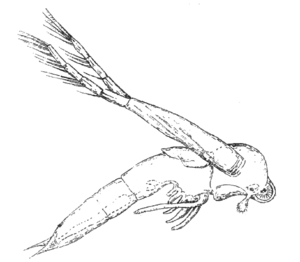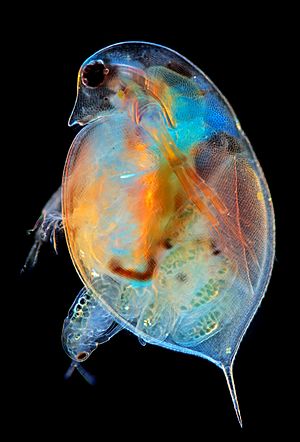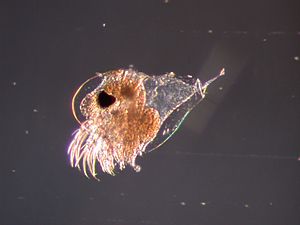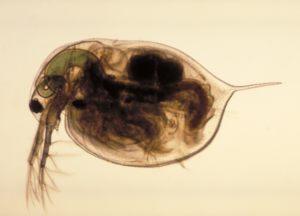Diplostraca facts for kids
Quick facts for kids Diplostraca |
|
|---|---|
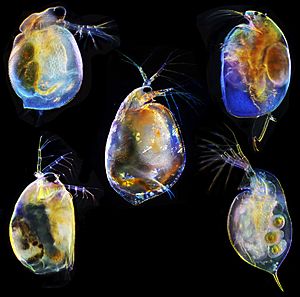 |
|
| Scientific classification |
|
| Kingdom: | Animalia |
| Phylum: | Arthropoda |
| Subphylum: | Crustacea |
| Class: | Branchiopoda |
| Subclass: | Phyllopoda |
| Superorder: | Diplostraca Latreille, 1829 |
| Orders | |
|
|
| Synonyms | |
|
|
Diplostraca, also known as Cladocera, are tiny creatures often called water fleas. They are a group of small crustaceans, like tiny shrimp. Most water fleas live in fresh water, such as ponds and lakes.
These amazing animals usually eat tiny bits of dead plants and animals, or even bacteria. Some types, however, are hunters and eat other small creatures. Scientists have found over 1,000 different kinds of water fleas. Many more are still waiting to be discovered!
The oldest water flea fossils are from the Jurassic period. This means they have been around for millions of years. Most water fleas are very small, usually between 0.2 and 6.0 millimeters long. They have a head that points downwards and a shell-like covering called a carapace. This carapace covers their body. Many water fleas can reproduce without a partner, which is called parthenogenesis. This helps them make many babies quickly.
Contents
What are Water Fleas Like?
Water fleas are usually very tiny. They are often only 0.2 to 6.0 millimeters long. That's smaller than a grain of rice! One type, called Leptodora, can grow much bigger, up to 18 millimeters long. Their bodies do not look like they have many parts. A folded shell, called a carapace, covers their middle and back sections.
Their head points downwards. It might have a special dip or notch. Most water fleas have one black eye in the middle of their head. They also have two pairs of antennae. The first pair is small. The second pair is large and branched. These large antennae have strong muscles. Water fleas use them to swim through the water. The tiny hairs, called setae, on their first antennae help them smell. The way these hairs are arranged on the second antennae helps scientists tell different types apart. The part of their head in front of the first antennae is called a "beak."
Water fleas have small mouthparts. These parts help them eat tiny bits of food. They eat "organic detritus," which is like tiny crumbs of dead things. They also eat bacteria.
Their middle body section has five or six pairs of special leg-like parts. These parts look like small leaves and have many hairs. Water fleas breathe through their body surface. They take in oxygen and release carbon dioxide this way.
Water Flea Life Cycle
Most water fleas reproduce in a special way. They mostly reproduce without a partner. This is called asexual reproduction or parthenogenesis. When conditions are good, they make many female babies that are exact copies of themselves. This can happen for several generations.
When conditions get bad, like when food is scarce, they start to make males. Then, sexual reproduction happens. This creates special eggs that can survive tough times. These "resting eggs" are very strong. They can be carried by the wind to new places. When they find good conditions, they hatch. This helps water fleas spread to many different parts of the world.
Most water fleas do not have a larval stage called a "nauplius." Only the Leptodora genus has a different larval stage.
Where Water Fleas Live
Most water flea species live in fresh water. This includes ponds, lakes, and rivers. Only a few types, about eight species, live in the ocean. These ocean-dwelling water fleas belong to a family called Podonidae. One type, Penilia, is also found in the ocean. Some water fleas even live in wet leaf litter on land.
How Water Fleas Are Grouped
Scientists group water fleas into a larger group called Branchiopoda. The names Diplostraca and Cladocera are both used for this group. Water fleas form a natural group of animals. They include 7 main orders, about 24 families, and more than 11,000 known species. There are still many more species that scientists have not yet named or described.
For example, the group Daphnia alone has about 150 different species. Many water flea groups are "cryptic species." This means they look very similar but are actually different species.
The word "Cladocera" comes from ancient Greek words. "Kládos" means "branch," and "kéras" means "horn." This might refer to the branched antennae or the shape of some water fleas.
See also
 In Spanish: Diplostráceos para niños
In Spanish: Diplostráceos para niños
- Bythotrephes longimanus (an invasive species, also known as Spiny Water Flea)
- Cercopagis pengoi (another invasive species)
- Daphnia lumholtzi (an invasive species)
- Moina (one of the smallest water fleas)
- Zooplankton


